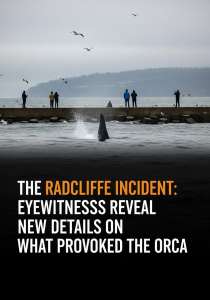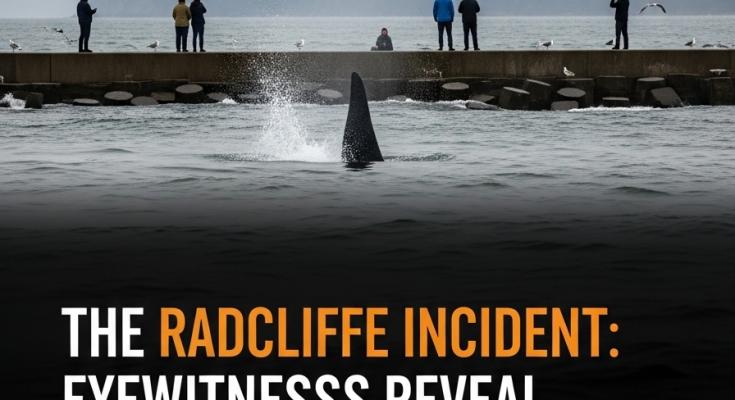The Radcliffe Incident: Eyewitnesses Reveal New Details on What Provoked the Orca
For two years, the story of what happened to Dr. Jessica Radcliffe has been shrouded in a fog of grief and carefully worded official statements. On that clear May afternoon at the Oceanic Institute of Monterey Bay, the world lost a brilliant marine biologist, and a narrative was born: a tragic, unpredictable accident. The official report from the Institute spoke of a “momentary lapse in situational awareness” and the inherent unpredictability of a wild animal.

But the placid surface of that official story is now being broken.
In a series of new, independent interviews, two eyewitnesses who were present during the incident have come forward. Their accounts, shared on the condition of anonymity, paint a drastically different picture of Jessica Radcliffe’s final moments—not of a simple mistake, but of a catastrophic environmental failure that provoked the orca, Kael, into a state of terror.
The Official Story: A Narrative of Human Error
Let’s first revisit the story the public was told. Dr. Radcliffe, a senior trainer and respected researcher, was conducting a post-session “enrichment exercise” with Kael, the Institute’s 14,000-pound male orca. She was on a submerged platform at the edge of the research pool. The Institute’s statement suggested she either slipped or her long, wet hair drifted into the water, triggering a “play-based” grab from Kael that tragically turned fatal.
The narrative placed the event squarely in the realm of the unknowable, a risk inherent to the job. It was a tragedy, yes, but one without a clear villain, preserving the reputation of both the beloved trainer and the multi-million-dollar animal.
That narrative is now falling apart.
The Grinding Gate: What Two Witnesses Saw
The new details come from two credible sources: a visiting marine veterinarian who was observing the session for a research paper, and a former Institute intern who has since left the field of marine biology, haunted by what they witnessed.
Both tell the same story.
The session was proceeding flawlessly. Dr. Radcliffe and Kael were a picture of mutual trust. “She had him completely engaged,” the veterinarian stated. “It was calm, focused, a textbook example of positive reinforcement. There was no lapse, no mistake.”
The trigger, they both insist, was not an action by Radcliffe, but a sound. A horrific, high-pitched, metallic screech.
“The hydraulic gate to the adjacent medical pool suddenly tried to engage,” the former intern explained. “It wasn’t supposed to. It made this bone-jarring grinding noise, a sound I’d never heard before. It went on for maybe five or six seconds.”
This is the critical detail omitted from the official report.
According to both witnesses, Kael’s entire demeanor changed in an instant. The calm, focused animal became agitated and panicked. He let out a series of high-frequency distress calls and began circling the pool erratically. “He was clearly terrified,” the vet recalled. “Orcas have incredibly sensitive hearing. A sound like that underwater would be excruciating, disorienting.”
A Desperate Attempt to De-escalate
Dr. Radcliffe, far from being the source of the problem, immediately transitioned into an emergency de-escalation protocol. She remained calm, using hand signals and vocal commands to try and soothe the panicked animal. She was trying to regain his focus, to pull him back from the edge of his fear.
It was in this moment of extreme agitation, with the orca spooked by a sudden, painful noise, that he grabbed her. It wasn’t play. It wasn’t a calculated act of aggression. According to the witnesses, it was a classic case of redirected aggression—the animal, unable to attack the source of its fear (the screeching gate), lashed out at the closest thing to him: the trainer he had trusted moments before.
“She wasn’t pulled in by her hair. He targeted her arm and shoulder,” the intern said, their voice trembling. “It was a reaction. A violent, fearful reaction to a sound that should have never happened. The park’s equipment failed, and it scared him to death.”
A Story of Negligence, Not Nature
This new information reframes the entire Radcliffe Incident. It shifts the narrative from one of unpredictable nature to one of potential institutional negligence. If a critical piece of machinery malfunctioned so catastrophically, it raises serious questions:
-
Why was this detail omitted from the official report?
-
What was the state of the park’s equipment and maintenance schedule?
-
Did the Oceanic Institute deliberately construct a false narrative to protect itself from liability?
The Oceanic Institute, when reached for comment on these new accounts, stated that they “stand by the findings of their comprehensive internal investigation” and that “speculation from un-named sources does not change the tragic reality of Dr. Radcliffe’s death.”
But for the rest of us, it changes everything.
Jessica Radcliffe was not the victim of a “killer whale.” Kael was not a monster who simply “turned.” They were both victims of a compromised environment. A steel gate, a terrifying sound, and a system that failed to protect either of them.
Dr. Radcliffe’s final performance was not a misstep. It was a desperate, heroic attempt to manage a crisis she didn’t create. Her death serves as a brutal lesson that in captivity, the walls themselves can be the greatest threat of all. The Radcliffe Incident is no longer just a story of an attack; it’s a story of a system that failed them both.

